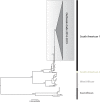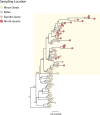Yellow Fever Virus Reemergence and Spread in Southeast Brazil, 2016-2019
- PMID: 31597773
- PMCID: PMC6912119
- DOI: 10.1128/JVI.01623-19
Yellow Fever Virus Reemergence and Spread in Southeast Brazil, 2016-2019
Erratum in
-
Correction for Giovanetti et al., "Yellow Fever Virus Reemergence and Spread in Southeast Brazil, 2016-2019".J Virol. 2020 May 18;94(11):e02008-19. doi: 10.1128/JVI.02008-19. Print 2020 May 18. J Virol. 2020. PMID: 32423967 Free PMC article. No abstract available.
Abstract
The recent reemergence of yellow fever virus (YFV) in Brazil has raised serious concerns due to the rapid dissemination of the virus in the southeastern region. To better understand YFV genetic diversity and dynamics during the recent outbreak in southeastern Brazil, we generated 18 complete and nearly complete genomes from the peak of the epidemic curve from nonhuman primates (NHPs) and human infected cases across the Espírito Santo and Rio de Janeiro states. Genomic sequencing of 18 YFV genomes revealed the estimated timing, source, and likely routes of yellow fever virus transmission and dispersion during one of the largest outbreaks ever registered in Brazil. We showed that during the recent epidemic, YFV was reintroduced from Minas Gerais to the Espírito Santo and Rio de Janeiro states multiple times between 2016 and 2019. The analysis of data from portable sequencing could identify the corridor of spread of YFV. These findings reinforce the idea that continued genomic surveillance strategies can provide information on virus genetic diversity and transmission dynamics that might assist in understanding arbovirus epidemics.IMPORTANCE Arbovirus infections in Brazil, including yellow fever, dengue, zika, and chikungunya, result in considerable morbidity and mortality and are pressing public health concerns. However, our understanding of these outbreaks is hampered by the limited availability of genomic data. In this study, we investigated the genetic diversity and spatial distribution of YFV during the current outbreak by analyzing genomic data from areas in southeastern Brazil not covered by other previous studies. To gain insights into the routes of YFV introduction and dispersion, we tracked the virus by sequencing YFV genomes sampled from nonhuman primates and infected patients from the southeastern region. Our study provides an understanding of how YFV initiates transmission in new Brazilian regions and illustrates that genomics in the field can augment traditional approaches to infectious disease surveillance and control.
Keywords: Southeast Brazil; genomic surveillance; outbreak; outbreak response; yellow fever.
Copyright © 2019 American Society for Microbiology.
Figures





Similar articles
-
Neighbor danger: Yellow fever virus epizootics in urban and urban-rural transition areas of Minas Gerais state, during 2017-2018 yellow fever outbreaks in Brazil.PLoS Negl Trop Dis. 2020 Oct 5;14(10):e0008658. doi: 10.1371/journal.pntd.0008658. eCollection 2020 Oct. PLoS Negl Trop Dis. 2020. PMID: 33017419 Free PMC article.
-
Evidence for multiple sylvatic transmission cycles during the 2016-2017 yellow fever virus outbreak, Brazil.Clin Microbiol Infect. 2018 Sep;24(9):1019.e1-1019.e4. doi: 10.1016/j.cmi.2018.01.026. Epub 2018 Feb 7. Clin Microbiol Infect. 2018. PMID: 29427798
-
Persistence of Yellow fever virus outside the Amazon Basin, causing epidemics in Southeast Brazil, from 2016 to 2018.PLoS Negl Trop Dis. 2018 Jun 4;12(6):e0006538. doi: 10.1371/journal.pntd.0006538. eCollection 2018 Jun. PLoS Negl Trop Dis. 2018. PMID: 29864115 Free PMC article.
-
Human Urban Arboviruses Can Infect Wild Animals and Jump to Sylvatic Maintenance Cycles in South America.Front Cell Infect Microbiol. 2019 Jul 17;9:259. doi: 10.3389/fcimb.2019.00259. eCollection 2019. Front Cell Infect Microbiol. 2019. PMID: 31380302 Free PMC article. Review.
-
Recent sylvatic yellow fever virus transmission in Brazil: the news from an old disease.Virol J. 2020 Jan 23;17(1):9. doi: 10.1186/s12985-019-1277-7. Virol J. 2020. PMID: 31973727 Free PMC article. Review.
Cited by
-
Back to Where It Was First Described: Vectors of Sylvatic Yellow Fever Transmission in the 2017 Outbreak in Espírito Santo, Brazil.Viruses. 2022 Dec 15;14(12):2805. doi: 10.3390/v14122805. Viruses. 2022. PMID: 36560809 Free PMC article.
-
Real-Time Genomic Surveillance during the 2021 Re-Emergence of the Yellow Fever Virus in Rio Grande do Sul State, Brazil.Viruses. 2021 Oct 1;13(10):1976. doi: 10.3390/v13101976. Viruses. 2021. PMID: 34696408 Free PMC article.
-
Retrospective Investigation in Horses with Encephalitis Reveals Unnoticed Circulation of West Nile Virus in Brazil.Viruses. 2022 Jul 14;14(7):1540. doi: 10.3390/v14071540. Viruses. 2022. PMID: 35891521 Free PMC article.
-
Evidence of co-circulation of multiple arboviruses transmitted by Aedes species based on laboratory syndromic surveillance at a health unit in a slum of the Federal District, Brazil.Parasit Vectors. 2021 Dec 19;14(1):610. doi: 10.1186/s13071-021-05110-9. Parasit Vectors. 2021. PMID: 34924014 Free PMC article.
-
Rational design of West Nile virus vaccine through large replacement of 3' UTR with internal poly(A).EMBO Mol Med. 2021 Sep 7;13(9):e14108. doi: 10.15252/emmm.202114108. Epub 2021 Aug 5. EMBO Mol Med. 2021. PMID: 34351689 Free PMC article.
References
-
- Nunes MR, Palacios G, Cardoso JF, Martins LC, Sousa EC Jr, de Lima CP, Medeiros DB, Savji N, Desai A, Rodrigues SG, Carvalho VL, Lipkin WI, Vasconcelos PF. 2012. Genomic and phylogenetic characterization of Brazilian yellow fever virus strains. J Virol 86:13263–13271. doi:10.1128/JVI.00565-12. - DOI - PMC - PubMed
Publication types
MeSH terms
LinkOut - more resources
Full Text Sources

